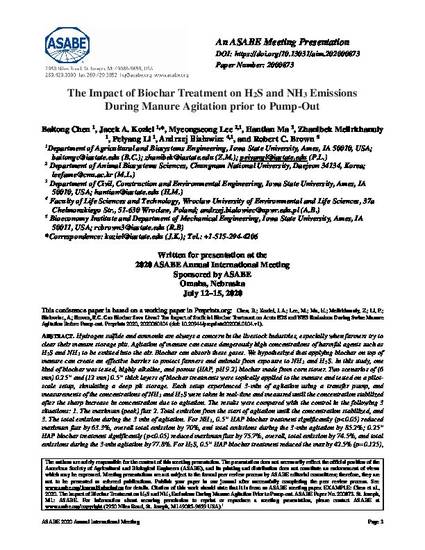
Hydrogen sulfide and ammonia are always a concern in the livestock industries, especially when farmers try to clear their manure storage pits. Agitation of manure can cause dangerously high concentrations of harmful agents such as H2S and NH3 to be emitted into the air. Biochar can absorb these gases. We hypothesized that applying biochar on top of manure can create an effective barrier to protect farmers and animals from exposure to NH3 and H2S. In this study, one kind of biochar was tested, highly alkaline, and porous (HAP, pH 9.2) biochar made from corn stover. Two scenarios of (6 mm) 0.25” and (12 mm) 0.5” thick layers of biochar treatments were topically applied to the manure and tested on a pilot-scale setup, simulating a deep pit storage. Each setup experienced 3-min of agitation using a transfer pump, and measurements of the concentrations of NH3 and H2S were taken in real-time and measured until the concentration stabilized after the sharp increase in concentration due to agitation. The results were compared with the control in the following 3 situations: 1. The maximum (peak) flux 2. Total emission from the start of agitation until the concentration stabilized, and 3. The total emission during the 3 min of agitation. For NH3, 0.5” HAP biochar treatment significantly (p<0.05) reduced maximum flux by 63.3%, overall total emission by 70%, and total emissions during the 3-min agitation by 85.2%; 0.25” HAP biochar treatment significantly (p<0.05) reduced maximum flux by 75.7%, overall, total emission by 74.5%, and total emissions during the 3-min agitation by 77.8%. For H2S, 0.5” HAP biochar treatment reduced the max by 42.5% (p=0.125), overall total emission by 17.9% (p=0.290), and significantly reduced the total emission during 3-min agitation by 70.4%; 0.25” HAP treatment reduced max by 60.6% (p=0.058), and significantly reduced overall and 3-min agitation‘s total emission by 64.4% and 66.6%, respectively.
Available at: http://works.bepress.com/jacek_koziel/380/

This proceeding is published as Chen, Baitong, Jacek A. Koziel, Myeongseong Lee, Hantian Ma, Zhanibek Meiirkhanuly, Peiyang Li, Andrzej Bialowiec, and Robert C. Brown. "The Impact of Biochar Treatment on H2S and NH3 Emissions During Manure Agitation prior to Pump-Out." Meeting Paper no. 2000873. 2020 ASABE Annual International Virtual Meeting. July 13-15, 2020. DOI: 10.13031/aim.202000873. Posted with permission.